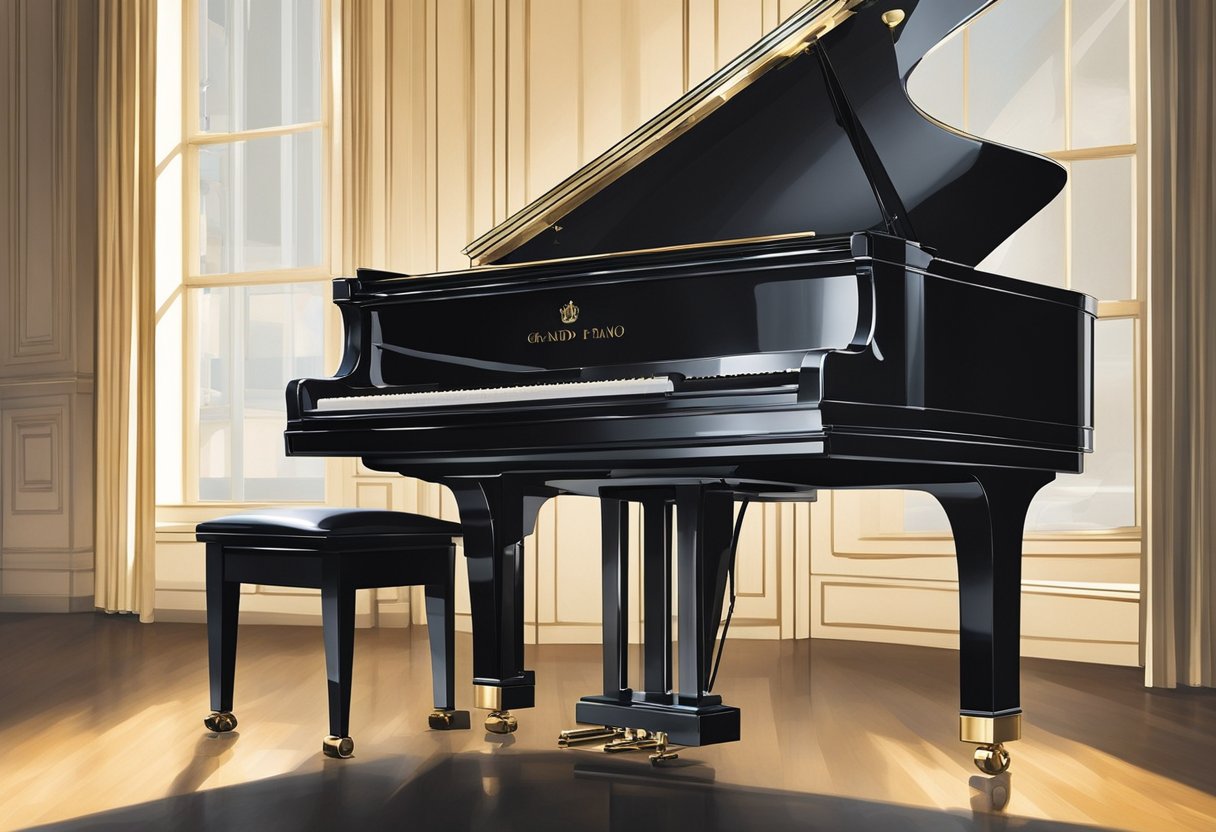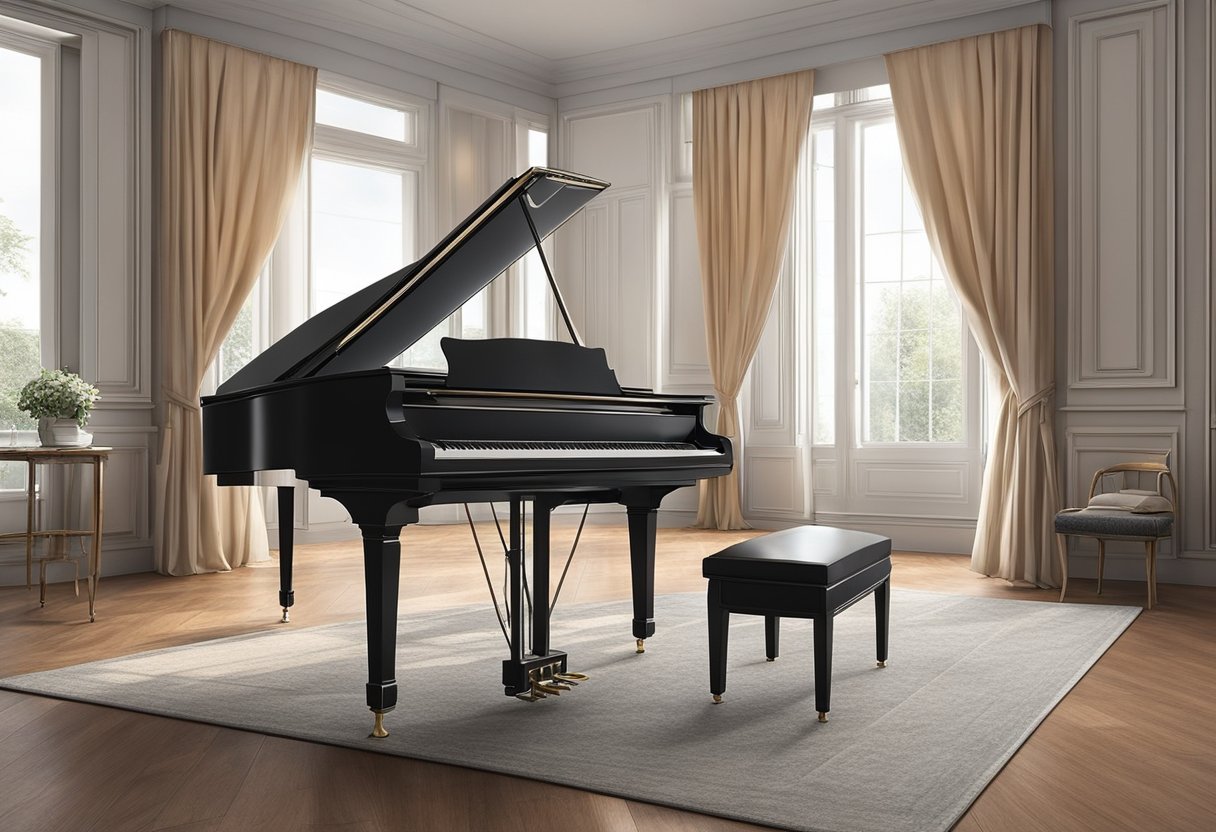As an Amazon Associate I earn from qualifying purchases.
Pianos are remarkably heavy due to a combination of dense materials and robust construction designed to create rich sounds. Your ordinary grand piano, for instance, has a cast iron frame that can weigh several hundred pounds alone, which is essential for supporting the tension of the strings and contributing to the instrument’s tonal quality.
I’ve often seen the surprise on students’ faces when they learn that a grand piano’s frame, sometimes referred to as the “harp,” can weigh more than an entire upright piano.
Want to Learn Piano?Click Here

The build of a piano is a fascinating harmony of art and engineering, and its weight is a testament to that complexity. Take an old upright piano in my teaching studio, its keys and intricate action mechanism are cradled within a solid wood casing made of durable hardwoods such as oak or walnut.
This provides not only stability to withstand the force of playing but also enhances the acoustic properties of the instrument—the denser the wood, the better the sound resonance.
The sheer mass of these instruments isn’t solely about durability; it’s a core element of the piano’s identity, ensuring that those 88 keys can deliver everything from the softest whisper to a thunderous roar.
Factors Influencing Piano Weight

When you consider the heft of a piano, several factors are at play, from the size and model differences to the specific heavy materials used in their construction. Understanding these elements will help you appreciate the varying weights of pianos.
Size and Model Differences
Different piano models come in various sizes, which contributes significantly to their weight. For example, a concert grand piano—the largest of the grand pianos—can weigh well over a thousand pounds.
On the other hand, baby grand pianos are smaller and lighter, but can still weigh around 500 pounds. Upright pianos vary less in size than grand pianos but still have different weights depending on the model, with some larger ones reaching up to 800 pounds.
Here’s a list of Steinway piano models and their weights:
| Steinway Model | Type | Weight (lbs) |
|---|---|---|
| Model S | Baby Grand | 540 |
| Model A | Grand | 695 |
| Model B | Classic Grand | 760 |
| Model D | Concert Grand | 990 |
| Model 1098 | Upright | 480 |
Material and Construction
The materials chosen for a piano’s construction are pivotal to its weight. Grand pianos are often made from dense woods like oak and mahogany, adding substantial weight. The frames within grand pianos are constructed from heavy metals like steel, which provide necessary strength but significantly increase the weight.
In my experience, the choice of these heavy materials is crucial; they’re selected for their sound quality as well as their durability.
The Role of the Soundboard and Case
The soundboard is the heart of a piano’s voice and is typically made from solid spruce, chosen for its excellent acoustic properties. Although spruce is lighter than the woods used for the outer case, the soundboard is large and thus contributes to the overall weight.
The outer case of a piano, especially for grand pianos, not only protects the inner mechanics but also enhances the instrument’s acoustic projection, necessitating sturdy construction. The case, crafted from those dense woods like oak or mahogany, encapsulates the piano and can add several hundred pounds to the instrument.
Different Piano Types and Their Weights
As you venture into the world of pianos, understanding the different types and their respective weights is essential, whether you’re a new enthusiast or a seasoned musician. This knowledge aids in various situations, from selecting the right instrument for your home to planning a move.
Varieties of Grand Pianos
Grand pianos, the crown jewels of the piano family, are renowned for their elegant shape and superior sound quality. Sizes range from the more compact Baby Grand, typically weighing between 500-600 lbs, to the Concert Grand, which can tip the scales up to 1200 lbs. T
he Parlor grand or Living room grand pianos usually fall somewhere in the middle, but all grand pianos share a horizontally oriented soundboard that contributes to their weight.
Vertical Piano Categories
Vertical pianos, known for their upright posture, offer a range of sizes and weights suitable for various homes and studio environments.
The compact Spinet Piano, the smallest of the group, can weigh as little as 200-300 lbs. Moving up the scale, the Console Piano strikes a balance in size with a weight of approximately 350-450 lbs.
For those seeking a more substantial instrument, Studio Pianos provide a larger frame and weight, usually 400-500 lbs, which is beneficial for sound resonance.
Comparing Digital and Acoustic Pianos
When considering digital pianos, weight becomes less of an issue—they are substantially lighter than their acoustic counterparts, often weighing under 100 lbs. In contrast, traditional acoustic pianos, whether grand or vertical, boast a heft owing to their wooden structures and cast iron frames.
This difference in weight has practical implications for portability and space, considerations that you, as a pianist, should take into account based on your individual needs and preferences.
Purchasing Considerations
When you decide to buy a piano, understanding the heaviness of the instrument is crucial. It’s not just about the initial purchase; weight affects everything from where you’ll place the piano to how you’ll move it.
Weight Concerns for Buyers
The weight of a piano can greatly vary depending on the model. For instance, a typical spinet piano, the smallest type of piano, might weigh around 300 pounds, whereas a living room grand piano can weigh over half a ton. A drawing room grand piano can be substantially heavier.
You need to consider the weight range when purchasing, as this will influence not only the cost of delivery but also the structural support needed wherever you choose to place the piano in your home.
Challenges in Piano Moving
Moving a piano is not a task to take lightly. The weight of a piano necessitates professional movers, as they can weigh anywhere from a few hundred to a thousand pounds. Moreover, the shape and size of pianos make them awkward to handle.
Special equipment and expertise are required to ensure the instrument isn’t damaged, and neither are your floors or walls during the move. Always plan for this part of the purchase process to avoid any surprises.
Hello & thanks for stopping by! I’m a professional concert pianist and piano instructor. In the United States, I’ve given successful performances in several places including New York, Florida, Connecticut, & New Jersey, I have also performed internationally in Italy and made my Carnegie Hall debut in 2014. I enjoy blogging about the piano, the art of performance, general music, current events and the latest in music production.
